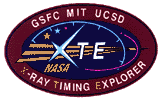However, these detector deadtime values, as measured by the HEXTE electronics and recorded in the science data, have been found to be significantly smaller than the actual deadtime experienced by the phoswich detector amplifier chains. The major cause for this discrepancy is a larger-than-expected baseline recovery time following scintillation pulses due to charged particle events. This results in effective livetimes which are about 15-40% less than inferred from the deadtime counter data. The resulting on-source livetime fraction during non-occulted, non-SAA periods is about 60%. However, this fraction varies from 40 up to 80%, depending on the charged particle rate and spectrum; both vary systematically over each orbit and each day.
The HEXTE team have provided the RXTE GOF with an algorithm, which corrects
the measured deadtime based on charged particle rates in the detectors, in
the form of an Ftool (HXTDEAD) which is currently being tested
for release.
The first version of this Ftool provides a correction only on the 16 s timescale for which the deadtime counter and the particle rates are telemetered. Initial results based on observations of the Crab nebula and pulsar indicate that this algorithm should be able to model the deadtime to an accuracy of a few percent over 16 s timescales.
The correction is appropriate for all observations made after 28 March 1996 at 22:10:00 UT when the HEXTE deadtime counter configuration was changed; an algorithm for earlier observations is still under development.
To give an indication of the effects this deadtime may have on timing results, a typical charged particle rate is 150 count/s per phoswich, with each event causing about 2.5 ms of deadtime. This results in ~40% deadtime. At its highest, the particle rate is near 400 count/s per phoswich, resulting in nearly 100% deadtime; however, this high rate occurs only very briefly on a limited number of orbits each day. For a rate of 200 count/s per phoswich, the Poisson uncertainty in the deadtime (neglecting other contributions) for 1s is 7%.

